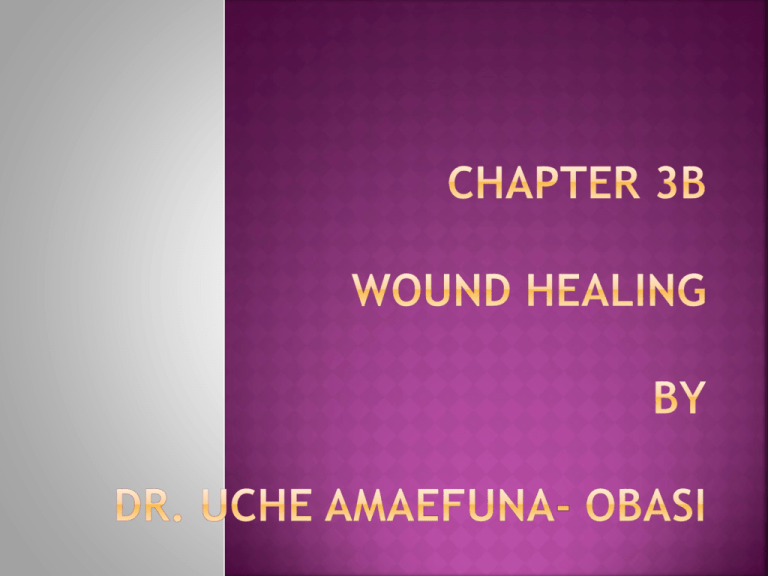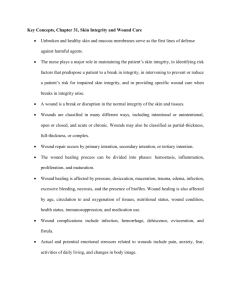Chapter 3b WOUND HEALING By Dr. Uche Amaefuna
advertisement

THERE ARE MORE TO LECTURES THAN JUST SLIDES…… Anatomy of Skin • Epidermis: Composed of several thin layers: stratum basale, stratum spinosum, stratum granulosum, stratum lucidum, stratum corneum. The several thin layers of the epidermis contain the following: a) melanocytes, which produce melanin, a pigment that gives skin its color and protects it from the damaging effects of ultraviolet radiation. b) keratinocytes, which produce keratin, a water Repellent protein that gives the epidermis its tough, Protective quality. Dermis: Composed of a thick layer of skin that contains collagen and elastic fibers, nerve fibers, blood vessels, sweat and sebaceous glands, and hair follicles. • Subcutaneous Tissue: Composed of a fatty layer of skin that contains blood vessels, nerves, lymph, and loose connective tissue filled with fat cells. Function of Integument • Protection: Intact skin prevents invasion of the body by bacteria • Thermoregulation: Intact skin facilitates heat loss and cools the body when necessary through the following processes: – production of perspiration which assists in cooling the body through evaporation – production of vasodilatation which assists in facilitating heat loss from the body through radiation and conduction – production of vasoconstriction which assists in preventing heat loss from the body through radiation and conduction. Fluid and Electrolyte Balance: Intact skin prevents the escape of water and electrolytes from the body • Vitamin D Synthesis • Sensation • Psychosocial Classification of Wounds • 1) Clean Wound: – Operative incisional wounds that follow nonpenetrating (blunt) trauma. • 2) Clean/Contaminated Wound: – Uninfected wounds in which no inflammation is encountered but the respiratory, gastrointestinal, genital, and/or urinary tract have been entered. • 3) Contaminated Wound: – Open, traumatic wounds or surgical wounds involving a major break in sterile technique that show evidence of inflammation. • 4) Infected Wound: – Old, traumatic wounds containing dead tissue and wounds with evidence of a clinical infection (e.g., purulent drainage). Classification of Wounds Closure • Healing by Primary Intention: – All Layers are closed. The incision that heals by first intention does so in a minimum amount of time, with no separation of the wound edges, and with minimal scar formation. • Healing by Secondary Intention: – Deep layers are closed but superficial layers are left to heal from the inside out. Healing by second is appropriate in cases of infection, excessive trauma, tissue loss, or imprecise approximation of tissue. • Healing by Tertiary Intention: – Also referred to as delayed primary closure. Wound Healing – Inflammation occurs when the damaged endothelial cells release cytokines that increase expression of integrands in circulating lymphocytes. – Histamine, serotonin, and kinins cause vessel contraction (thromboxane), decrease in blood loss, and act as chemotactic factors for neutrophils, the most abundant cells in the initial 24 hour period. – Proliferative phase occurs next, after the neutrophils have removed cellular debris and release further cytokines acting as attracting agents for macrophages. – Fibroblasts now migrate into the wound, and secrete collagen type III. – Angiogenesis occurs by 48 hours. – The secretion of collagen, macrophage remodeling and secretion, and angiogenesis continues for up to 3 weeks. – The greatest increase in wound strength occurs during this phase. – Maturation phase is the final phase and starts from the 3rd week and continues for up to 9-12 months. – This is where collagen III is converted to collagen I, and the tensile strength continues to increase up to 80% of normal tissue. Surgical Wound Infection – Incisional infections identified by purulent or culture positive drainage is isolated from any structure above the fascia in proximity to the initial wound – Deep infections are characterized by purulent drainage from subfascial drains, wound dehiscence, or abscess formation and involve adjacent sites manipulated during surgery. – Wound Dehiscence – Breakdown of the surgical wound Risk Factors for SWI – Patient-related factors: – Age > 60, sex (female), weight (obesity) – Presence of remote infections – Underlying disease states Diabetes, Congestive heart failure (CHF), Liver disease, renal failure – Duration of preoperative stay hospitalization > 72 hours, ICU stay – Immuno-suppression – ASA (American Society of Anesthesiologists) – physical status (3,4, or 5) Surgery-related factors: – Type of procedure, site of surgery, emergent surgery – Duration of surgery (>60- 120 min) – Previous surgery – Timing of antibiotic administration – Placement of foreign body – Hip/knee replacement, heart valve insertion, shunt insertion – Hypotension, hypoxia, dehydration, hypothermia Surgery related factors: Patient preparation – Shaving the operating site – Preparation of operating site – Draping the patient – Surgeon preparation – Hand washing – Skin antiseptics – Gloving Wound-related – – – – – – – factors: Magnitude of tissue trauma and devitalization Blood loss, hematoma Wound classification Potential bacterial contamination Presence of drains, packs, drapes Ischemia Wound leakage Antibiotic Use Characteristics of an optimal antibiotic for surgical prophylaxis: – Effective against suspected pathogens – Does not induce bacterial resistance – Effective tissue penetration – Minimal toxicity – Minimal side effects – Long half-life – Cost effective Antibiotic Use Appropriate antibiotic use for prevention of SWI includes the following: – Appropriate timing of administered agents and repeated dosing based on length of procedure and antibiotic half-life Consider redosing if procedure > 4 hours – Appropriate selection based on procedure performed – Appropriate duration to avoid infection and decrease potential for development of resistance Antibiotic – Use Nose S. aureus, pneumococcus, meningococcus – Skin S. aureus, S. epidermidis – Mouth/pharynx Streptococci, pneumococcus, e.coli, bacteroides, fusobacterium, peptostreptococcus – Urinary tract E.coli, proteus, klebsiella, enterobacter Antibiotic – Use Colon E. coli, klebsiella, enterobacter, bacteroides spp, peptostreptococci, clostridia – Biliary tract E. coli, klebsiella, proteus, clostridia – Vagina Streptococci, staphylococci, E. coli, Peptostreptococci, bacteroides spp. – Upper respiratory tract Pneumococcus, H. influenzae Antibiotic Use Identify wound infection risk based on patient’s surgical procedure: – Clean: Cefazolin – Clean/contaminated: Cefazolin vs broad spectrum (Cefoxitin or Cefotetan) – Contaminated: Broad spectrum (Cefoxitin or Cefotetan) – Dirty: Therapeutic antibiotics Fetal Wound Healing – Fetal wound healing proceeds without fibrosis or scar formation in contrast to adult wound healing. The mechanisms responsible for this remarkable process are mediated in part through a fetal wound extracellular matrix rich in hyaluronic acid (HA). – Proposed contributing factors to scarless healing in fetal wounds are the presence of fewer neutrophils and more monocytes during the inflammatory period, different concentrations of cytokines, and a greater proportion of type III collagen in contrast to adult wounds. Fetal Wound Healing – Transforming growth factor-b (TGF- β, specifically, low levels of TGF-β1 and TGF- β2 and high levels of TGF- β3—probably has a central role in scar formation, and studies of its role are ongoing. – Low levels of platelet-derived growth factor (PDGF), a greater amount of epidermal growth factor (a mitogen for epithelialization), a faster rate of wound healing, and a greater amount of hyaluronic acid in the extracellular matrix has been documented and suggests a more efficient process of wound healing in fetal models. Staging of Pressure Ulcers • Stage I: redness and warmth • Stage II: shallow ulcer with distinct edges • Stage III: full-thickness loss of skin • Stage IV: involvement of fascia, connective tissue, muscle and bone • Stage V: area covered with black eschar (aka scab) Hypertrophic Scars and Keloids • The natural response to injury involves several stages of wound healing, migration of macrophages, neutrophils, and fibroblasts and the release of cytokines and collagen in an array to promote wound healing and maturation. • Hypertrophy and keloid formation are an overactive response to the natural process of wound healing. Hypertrophic Scars • These lesions are raised and thickened. • This process does not extend beyond the boundary of the incision/scar. • This process is exacerbated by tension lines on the area of surgery: incisions over the knee and elbow have a higher incidence of hypertrophic reaction. NOTE: hypertrophic scars and keloids are indistinguishable by plain H&E staining. • Treatment: nearly all hypertrophic scars undergo a degree of spontaneous resolvement. • If still present after six months, surgical excision is indicated. • Pressure applied early to a lesion is also of benefit. • Intractable lesions can be injected with triamcinolone Keloids • Raised and thickened. This process extends beyond the boundary of the incision. – Continues weeks to months past the initial insult. • Higher incidence in African Americans. • May have different incidences in different parts of the same person;– may not develop a keloid on the arm, yet has a keloid after earring insertion. Keloids • NOTE: hypertrophic and keloids are indistinguishable by plain H&E staining. • Treatment: Pressure applied early may decrease the extent of keloid formation. • Injection of triamcinolone, or corticosteroid injection may be helpful. • Excision with intramarginal borders is reserved for intractable keloids, and used in conjunction with the above.





